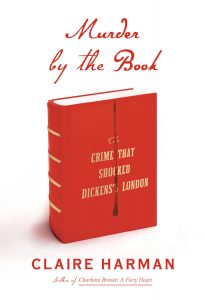 Like many True Crime books, Murder by the Book starts with a bloody crime, a man with his throat cut in his own bed. London in 1840 was a pretty grim place, but the reason this crime became a veritable national sensation didn’t have much to do with the gore of the thing or the apparent brazenness of it, but the simple fact that it happened to a member of the uppermost crust, Lord William Russell. Forget the miserable and dangerous lives of the poor, when an aristocrat got murdered, the new consort, Prince Albert, and the old general, the Duke of Wellington, wanted to see the matter cleared up as soon as possible.
Like many True Crime books, Murder by the Book starts with a bloody crime, a man with his throat cut in his own bed. London in 1840 was a pretty grim place, but the reason this crime became a veritable national sensation didn’t have much to do with the gore of the thing or the apparent brazenness of it, but the simple fact that it happened to a member of the uppermost crust, Lord William Russell. Forget the miserable and dangerous lives of the poor, when an aristocrat got murdered, the new consort, Prince Albert, and the old general, the Duke of Wellington, wanted to see the matter cleared up as soon as possible.
The solution of the case is not really the story here, and the culprit, unlike most fictional mysteries, is the most obvious person. The investigation itself is no Holmesian triumph, either. Lacking forensic science, the forces of justice more crudely rely on mysteriously appearing evidence and contradictory confessions.
With a crime this old, the mists of time can obscure a lot of detail, leading to as much conjecture as hard fact, but author Claire Harman makes the narrative absorbing with related threads in the complicated, often surprising Victorian tapestry. There’s the contemporary criminal, Edward Oxford, who took a couple of pot shots at Queen Victoria and the aforementioned Prince Albert. Harman tells us that “Oxford had recently lost a job at the Hog and Pound in Oxford Street because of his unaccountable fits of laughing.” It exposes the myth of the staid Victorian to learn that Lord Russell’s neighbor, the artist William Landseer, who rushed to the scene of the crime, was having an “affair with Georgiana, Duchess of Bedford, a woman twenty-one years his senior” which “started when he was still a teenager; he was thought to be the father of her last two children.” This is the kind of trivia that makes the milieu come alive.
But there were more serious issues at play. In an era of vast economic disparity and a growing realization that perhaps that disparity wasn’t divinely ordained, there was a general apprehension that at any moment the lower classes might storm the mansions of the upper classes, slit their throats and steal their stuff, and a crime like this only stoked those fears (or in some cases hopes). But rather than concentrate on the outrages committed on the poor, proper society preferred to focus on the outrages committed by the poor.
Another strategy to manage anxiety about social change and crime is one familiar to our own time — blame the media. In this case, outrage centered on a sensational and extremely popular novel Jack Sheppard by W. Harrison Ainsworth, which mirrored and perhaps even influenced the crime. The general condemnation moved Charles Dickens to distance himself both from one time friend Ainsworth and his own crime fiction like Oliver Twist. The romance of a dashing criminal was amplified by half a dozen unauthorized theatrical adaptations, which reached far more of the lower classes than the book. The irony that “justice” itself conducted a violent spectacle in the form of public executions more greatly attended than any play was lost on a self-satisfied society.
As you can tell, I found Murder by the Book to be an intriguing narrative and food for thought. If over the years the facts may appear to be a bit thin, Harman has managed to write an illuminating vision of crime and consequence. –Jamie